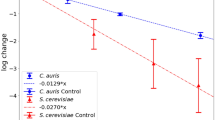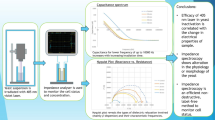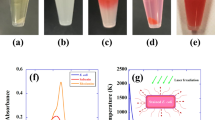Abstract
Ultraviolet (UV) irradiation has high potential to inactivate a wide range of biologic agents and is one of several nonadditive technologies being studied. The photoinactivation property of pulsed UV laser radiation (at wavelengths of 355 and 266 nm), used as an effective physical means to inactivate two typical microorganisms, prokaryotic (Escherichia coli K12) and eukaryotic (Saccharomyces cerevisiae), with respect to dose and exposure times, was examined. An E. coli population of 1.6 × 104 colony-forming units (CFU)/ml was inactivated with a dose of 16.7 J/cm2 energy at 355-nm wavelength. However, E. coli cells at higher concentrations were inactivated by only 98% using the same dose. Interestingly, an E. coli population of 2 × 107 CFU/ml was completely inactivated using only 0.42 J/cm2 at 266-nm wavelength (P ≤ 0.05). With respect to S. cerevisiae, the results were similar to those of E. coli irradiation considering that S. cerevisiae is 100 times larger than E. coli. A dose of 16.7 J/cm2 completely inactivated an S. cerevisiae population of 6 × 103 CFU/ml at 355-nm wavelength. Exposure to 266-nm wavelength, with energy doses of 1.67, 0.835, and 0.167 J/cm2, successfully inactivated S. cerevisiae populations of 3 × 106, 1.4 × 105, and 1.5 × 104 CFU/ml, respectively (P ≤ 0.05). In conclusion, compared with 355-nm wavelength, a pulsed UV laser at 266-nm wavelength inactivated a high titer of bacterial and yeast indicator standards suspended in phosphate-buffered saline-A.




Similar content being viewed by others
References
Arami S, Hada M, Tada M (1997) Near-UV-induced absorbance change and photochemical decomposition of ergosterol in the plasma membrane of the yeast Saccharomycs cerevisiae. Microbiology 143:1665–1671
Chang JCH, Ossoff SF (1985) UV Inactivation of pathogenic and indicator microorganisms. Appl Environ Microbiol 49:1361–1365
Chilbert MA, Peak MJ, Peak GJ et al (1988) Effects of intensity and fluence upon DNA single-strand breaks induced by excimer laser radiation. Photochem Photobiol 47:523–525
Falkenstein Z (2001) Development of an excimer UV light source system for water treatment. Ushio America
Ghasemi Z, Macgregor S, Anderson J et al (2003) Development of an integrated solid-state generator for light inactivation of food-related pathogenic bacteria. Meas Sci Technol 14:N26–N32
Hijnen WAM, Beerendonk EF, Medema GJ (2006) Inactivation credit of UV radiation for viruses, bacteria and protozoan (oo)cysts in water: A review. Water Res 40:3–22
Nikogosyan DN, Oraevsky AA, Zavilgelsky GB (1986) Picosecond laser UV inactivation of λ bacteriophage and various Echerichia coli strains. Photochem Photobiophys 10:189–198
Oguma K, Katayama H, Ohgaki S (2002) Photoreactivation of Escheritia coli after low- or medium-pressure UV disinfection determined by an endonuclease sensitive site assay. Appl Environ Microbiol 68:6029–6035
Oppezzo OJ, Pizarro RJ (2001) Sublethal effects of ultraviolet A radiation on Enterobacter cloacae. J Photochem Photobiol B 62:158–165
Petin VG, Kim JK, Rassokhina AV et al (2001) Mitotic recombination and inactivation in Saccharomycs cerevisiae induced by UV-radiation (254 nm) and hyperthermia depend on UV fluence rate. Mutat Res 478:169–176
Rice JK, Ewell M (2001) Examination of peak power dependence in the UV inactivation of bacterial spores. Appl Environ Microbiol 67:5830–5832
Schuerger AC, Richards JT, Newcombe DA et al (2006) Rapid inactivation of seven Bacillus spp. under simulated Mars UV irradiation. Icarus 181:52–62
Sommer R, Haider T, Cabaj A et al (1996) Increased inactivation of Saccharomycs cerevisiae by protraction of UV irradiation. Appl Environ Microbiol 62:1977–1983
Sosnin EA, Lavrent’eva LV, Yusupov MR et al (2002) Inactivation of escherichia coli using capacitive discharge excilamps. 2nd International Workshop on Biological Effects of Electromagnetic Field, Rhodes, Greece, pp. 384–388
Takeshita K, Shibato J, Sameshima T et al (2003) Damage of yeast cells induced by pulsed light irradiation. Int J Food Microbiol 85:151–158
Wang T, Macgregor SJ, Anderson JG et al (2005) Pulsed ultra-violet inactivation spectrum of Echerichia coli. Water Res 39:2921–2925
Zimmer JL, Slawson RM (2002) Potential repair of Escherichia coli DNA following exposure to UV radiation from both medium- and low-pressure UV sources used in drinking water treatment. Appl Environ Microbiol 68:3293–3299
Acknowledgments
This work was supported by a research grant (D-85-1270) funded by Shahid-Beheshti University, Tehran, Iran. Also, we would like to thank Dr. AR Heydari, WS University, Michigan, for his critical review of this manuscript.
Author information
Authors and Affiliations
Corresponding author
Rights and permissions
About this article
Cite this article
Azar Daryany, M.K., Massudi, R. & Hosseini, M. Photoinactivation of Escherichia coli and Saccharomyces cerevisiae Suspended in Phosphate-Buffered Saline-A Using 266- and 355-nm Pulsed Ultraviolet Light. Curr Microbiol 56, 423–428 (2008). https://doi.org/10.1007/s00284-008-9110-3
Received:
Accepted:
Published:
Issue Date:
DOI: https://doi.org/10.1007/s00284-008-9110-3




